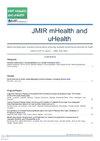空气污染信息对个人锻炼行为的影响:使用可穿戴设备和移动设备数据的实证研究
IF 5.4
2区 医学
Q1 HEALTH CARE SCIENCES & SERVICES
引用次数: 0
摘要
背景:体育锻炼和暴露于空气污染会对个人的健康产生反作用。有关个人对不同污染信息源的实时运动行为反应的知识仍然不足。研究目的本研究旨在探讨个体在运动过程中根据不同的空气污染信息源避开污染空气的程度。研究方法我们使用了通过可穿戴设备和移动设备获取的中国 83 个城市两年内的个人运动行为数据。在我们的数据集中,35.99%(5896/16379)的个体为女性,64%(10483/16379)的个体为男性,年龄主要介于 18 岁至 50 岁之间。我们还利用空气污染信息(包括城市每小时的空气质量指数和颗粒物 2.5 浓度(单位:µg/m3))和天气数据(包括城市每小时的气温( ºC)、露点( ºC)、风速(米/秒)和风向(度))进一步增强了运动行为数据。我们使用线性面板固定效应模型来估计个人的运动厌恶行为(即个人小时、城市小时或城市日级别的跑步运动距离),并使用内生处理效应模型和回归不连续法进行稳健性检验。我们研究了其他空气污染信息源是否可以缓和(即替代或补充)主流空气污染指标的作用。结果我们的结果表明,在中度到重度空气污染的情况下,个人的跑步锻炼行为减少了约 0.50 公里(或 7.5%;P<.001),而在轻度空气污染的情况下,没有证据表明跑步距离会减少。此外,不同的替代信息来源,如社会关系和社交媒体用户生成的有关空气污染的内容,也会增强个人对主流空气污染信息的厌恶运动行为。结论:我们的研究结果凸显了不同的空气污染替代信息源在诱导个人厌恶行为方面的互补作用,以及在官方空气污染警报之外利用不同信息渠道提高公众意识的重要性。本文章由计算机程序翻译,如有差异,请以英文原文为准。
The Impact of Air Pollution Information on Individuals’ Exercise Behavior: Empirical Study Using Wearable and Mobile Devices Data
Background: Physical exercise and exposure to air pollution have counteracting effects on individuals’ health outcomes. Knowledge on individuals’ real-time exercise behavior response to different pollution information sources remains inadequate. Objective: This study aims to examine the extent to which individuals avoid polluted air during exercise activities in response to different air pollution information sources. Methods: We used data on individuals’ exercise behaviors captured by wearable and mobile devices in 83 Chinese cities over a 2-year time span. In our data set, 35.99% (5896/16,379) of individuals were female and 64% (10,483/16,379) were male, and their ages predominantly ranged from 18 to 50 years. We further augmented the exercise behavior data with air pollution information that included city-hourly level measures of the Air Quality Index and particulate matter 2.5 concentration (in µg/m3), and weather data that include city-hourly level measures of air temperature (ºC), dew point (ºC), wind speed (m/s), and wind direction (degrees). We used a linear panel fixed effect model to estimate individuals’ exercise-aversion behaviors (ie, running exercise distance at individual-hour, city-hour, or city-day levels) and conducted robustness checks using the endogenous treatment effect model and regression discontinuity method. We examined if alternative air pollution information sources could moderate (ie, substitute or complement) the role of mainstream air pollution indicators. Results: Our results show that individuals exhibit a reduction of running exercise behaviors by about 0.50 km (or 7.5%; P<.001) during instances of moderate to severe air pollution, and there is no evidence of reduced distances in instances of light air pollution. Furthermore, individuals’ exercise-aversion behaviors in response to mainstream air pollution information are heightened by different alternative information sources, such as social connections and social media user-generated content about air pollution. Conclusions: Our results highlight the complementary role of different alternative information sources of air pollution in inducing individuals’ aversion behaviors and the importance of using different information channels to increase public awareness beyond official air pollution alerts.
求助全文
通过发布文献求助,成功后即可免费获取论文全文。
去求助
来源期刊

JMIR mHealth and uHealth
Medicine-Health Informatics
CiteScore
12.60
自引率
4.00%
发文量
159
审稿时长
10 weeks
期刊介绍:
JMIR mHealth and uHealth (JMU, ISSN 2291-5222) is a spin-off journal of JMIR, the leading eHealth journal (Impact Factor 2016: 5.175). JMIR mHealth and uHealth is indexed in PubMed, PubMed Central, and Science Citation Index Expanded (SCIE), and in June 2017 received a stunning inaugural Impact Factor of 4.636.
The journal focusses on health and biomedical applications in mobile and tablet computing, pervasive and ubiquitous computing, wearable computing and domotics.
JMIR mHealth and uHealth publishes since 2013 and was the first mhealth journal in Pubmed. It publishes even faster and has a broader scope with including papers which are more technical or more formative/developmental than what would be published in the Journal of Medical Internet Research.
 求助内容:
求助内容: 应助结果提醒方式:
应助结果提醒方式:


